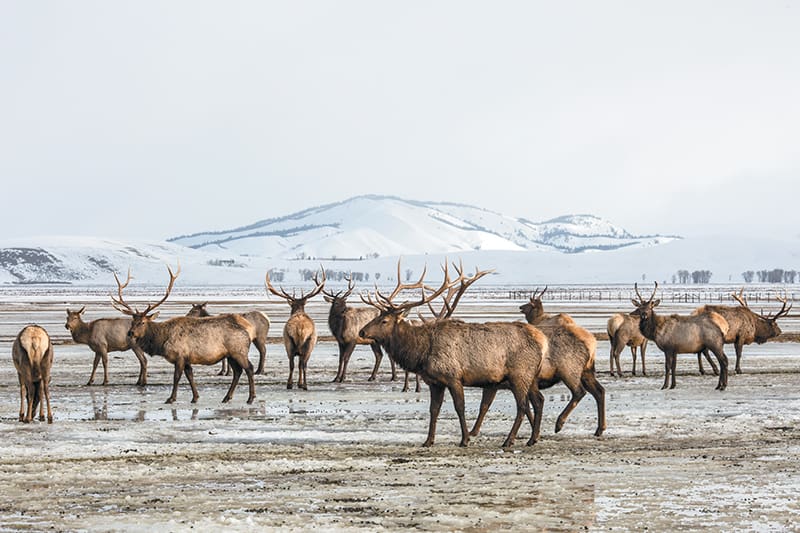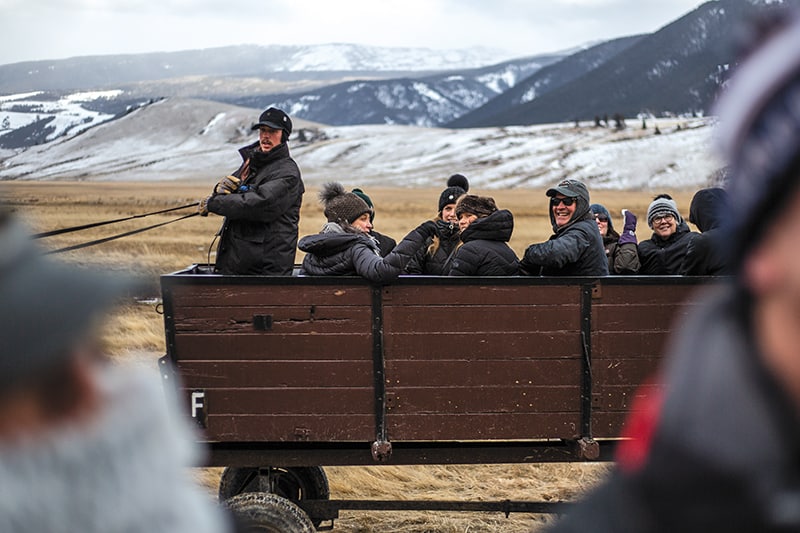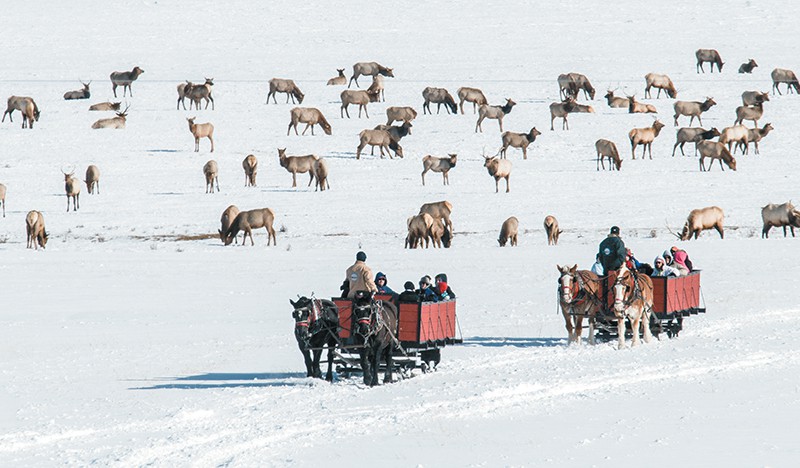Read The
Current Issue
Hiding in Plain Sight
You can’t approach an elk on foot without scaring it (and you shouldn’t because approaching large wildlife is illegal and dangerous). But you can take a horse-drawn sleigh ride into the middle of the herd wintering on the National Elk Refuge.
By Cody Cottier

Elk roam the lowlands of the National Elk Refuge as the ground begins to thaw. Photo by Ryan Dorgan
AS OUR RED wooden sleigh rumbled and jangled along well-trodden ruts, hundreds of indistinct brown dots peppered the snowy ground in the distance. It was March 21, the day after the equinox, and the atrophied spring sun was just beginning to limber up for a new season. It shone on the swooping Teton peaks to the north, on the bustling town of Jackson to the south, and, all around, on a sea of shimmering white. But our eyes were set dead ahead, on the far-off figures slowly growing recognizable as winter-toughened wapiti that had come down from the mountains to feed.
Their migration brought them—as it has each year for far longer than humans have been around to admire and Instagram it—to the lands of what is now the National Elk Refuge: a 25,000-acre swath of the valley floor where they gather by the thousands. Snow as deep as 15 feet (or about 50 elk hooves) buried their alpine summer grazing grounds above. A sleigh drawn by a pair of Percheron draft horses named Thunder and Lightning brought me and a dozen or so bundled and blanket-wrapped tourists up close and personal with a couple of bunches of the 8,000 elk estimated to be on the refuge.
“They don’t see us as a bunch of people with sleighs and horses,” Warburton said. “To them, we’re just one big, funny-looking creature.”
Our sleigh, which driver Michael Warburton cautioned didn’t have a parking brake, jerked across the snow like an old wooden roller coaster. Looking over the edge I noticed ubiquitous
clusters of semi-frozen elk scat; these little brown dots were the first sign of the immense brown dots: Within a few minutes of settling onto the leather benches, we neared our first group of elk. It was easy to make them out as they plodded through the two-foot (six-hoof) snowpack, scratching at the hidden grass underneath or just lazing, trying to save their energy. Though a human approaching on foot would send them running, in our sleigh we got close enough to hear the elk grunting and snorting just a few yards away, the smell of their musty coats wafting toward us. “They don’t see us as a bunch of people with sleighs and horses,” Warburton said. “To them, we’re just one big, funny-looking creature.”
CONGRESS ESTABLISHED THE National Elk Refuge in 1912 after several winters during which large numbers of Jackson Hole elk died due to the growing town of Jackson’s location smack in the middle of the animal’s historic winter range, and also because of competition from domestic livestock. According to Warburton, early settlers gave surreal accounts of being able to walk half a mile out of town without touching the ground. “They would just step from the back of one dead elk to the next,” he said. The winter wanderings of these iconic ungulates from the high alpine reaches to the valley floor likely go back centuries or millennia. “These elk are here,” Warburton said, “because their mother brought them here their first wintertime, and her mother before them, back through the generations.”
The U.S. Fish and Wildlife Service (USFWS) has managed the refuge since 1940. During all but the mildest of Jackson Hole winters, the USFWS puts out alfalfa pellets for the animals because foraging through deep and ice-crusted snow is difficult and energy-sapping. (This feeding program is highly controversial for its potential to promote disease among dense herds, but that’s a story on its own: Read it online in the winter 2019 issue of Jackson Hole magazine.)
Even with feeding, the past few months of record-breaking snowfall have not been easy on Jackson Hole’s elk. In fact, the first elk we saw up close had recently died. (In an average winter about 1.5 percent of the herd perishes, according to refuge biologist Eric Cole.) Many of the living elk sported shaggy coats. But despite their haggard appearance, the elk still had a certain majesty. Their lumbering bodies were massive, a fact that was difficult to appreciate until the sleigh drew very close. The ones that weren’t mangy had gorgeous, long, beige and chestnut fur. Warburton guided Thunder and Lightning to a couple of different groups. While there were thousands of elk on the refuge, they hung out in smaller groups of several dozen each. These groups stretched as far as the eye could see. Every few moments I was freshly awed at the sheer size of the throng.
While there were thousands of elk on the refuge, they hung out in smaller groups of several dozen each. These groups stretched as far as the eye could see. Every few moments I was freshly awed at the sheer size of the throng.
Mid-March is smack in the middle of shedding season. (Male elk lose, or “shed,” their antlers every year and grow new ones.) We saw bull elk that still had both their antlers, others with no antlers, and, occasionally, a goofy-looking uni-antler elk. We didn’t see any antlers actually fall off; but Lori Iverson, a refuge spokeswoman who was along on the sleigh ride, said that in her 14 years on the job she’s never seen an elk drop an antler either. This didn’t stop her from initiating stare-downs with wobbly-antlered bulls and swinging her head wildly, challenging them to shake off the loose appendages.
WHILE IT IS the National Elk Refuge, many other species call this area home, including bison, wolves, coyotes, mountain lions, ravens, and eagles. We saw the last two on the carcass of the dead elk. The eagle scavenged assertively while an unkindness of ravens (yes, that is the official term for a group of ravens; quite fitting from the elk’s perspective) stood in line. On the far side of the herd more eagles circled. I saw several coyotes skulking about, no doubt with similar intentions.
With the circle of life on full display, we marveled in silence for awhile at the wintry Serengeti-like scene. The snow underhoof glistened as the elk wandered to and fro, nibbling at the icy grass they’d uncovered. In a couple of months, they’d trek back to their summer homes high in the surrounding mountains. But in March they roamed before us, congregated in bewildering bulk, outlasting the cold in wait of warmer days. JH
Nuts & Bolts
From mid-December into early April, sleigh rides depart daily from the Jackson Hole and Greater Yellowstone Visitor Center several times an hour between 10 a.m. and 4 p.m. The National Elk Refuge’s private contractor, Double H Bar, Inc, charges $25 for for adults and $15 for children 5-12; kids under 4 are free. Private sleighs cost $450 and can fit up to 18 people; 307/733-0277; bit.ly/JHmW20Elk

Depending on snowfall, sleighs switch between wheels and runners. Photo by Ryan Dorgan

Sleigh drivers steer their teams on the National Elk Refuge. Photo by Bradly J. Boner




